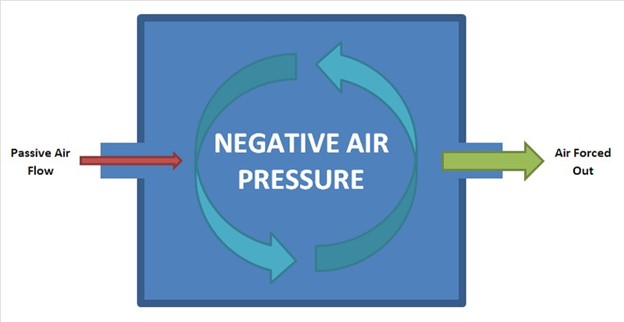A client is admitted with rule out tuberculosis.
What extra safety precautions must be in place to care for this client? Select all that apply.
Gloves, mask, and gown.
N95 mask.
Droplet precautions.
Contact precautions.
Private room with negative air pressure
Correct Answer : E
A private room with negative air pressure is required to care for a client with suspected or confirmed tuberculosis (TB) disease, as this is part of the airborne precautions recommended by the CDC.

A private room with negative air pressure prevents the spread of infectious droplet nuclei that contain the TB bacteria.
Choice A is wrong because gloves, masks, and gowns are not sufficient to protect against TB transmission.
Gloves and gowns are used for contact precautions, which are not indicated for TB.
A regular mask is also not effective in filtering out the small droplet nuclei that carry the TB bacteria.
Choice B is wrong because an N95 mask is not a precaution for the client, but for the healthcare personnel who are in close contact with the client.
An N95 mask is a type of respirator that can filter out at least 95% of airborne particles, including TB bacteria. Health care personnel should wear an N95 mask when entering the client’s room or performing aerosol-generating procedures on the client.
Choice C is wrong because droplet precautions are not indicated for TB.
Droplet precautions are used for infections that are spread by large respiratory droplets that do not remain suspended in the air, such as influenza or pertussis. Droplet precautions require wearing a regular mask and eye protection when within 6 feet of the client.
Choice D is wrong because contact precautions are not indicated for TB.
Contact precautions are used for infections that are spread by direct or indirect contact with the client or the client’s environment, such as Clostridium difficile or MRSA. Contact
Nursing Test Bank
Naxlex Comprehensive Predictor Exams
Related Questions
Correct Answer is A
Explanation
This is because the patient may be experiencing serotonin toxicity, a potentially life- threatening condition caused by excessive levels of serotonin in the brain. Paroxetine (Paxil) is a selective serotonin reuptake inhibitor (SSRI) that increases serotonin levels, and some other medications or supplements may interact with it and cause serotonin toxicity. Some of the symptoms of serotonin toxicity include agitation, increased sweating, and hallucinations.
Choice B is wrong because administering an anti-anxiety medication may worsen serotonin toxicity, especially if the medication is also an SSRI or another serotonergic agent.
Choice C is wrong because placing the patient in loose bilateral arm restraints may increase the risk of injury or agitation, and does not address the underlying cause of the symptoms.
Choice D is wrong because telling the patient that the voices they are hearing are not real may not be helpful or reassuring, and may also increase the patient’s distress or confusion.
Correct Answer is A
Explanation
This is because diarrhea can cause a loss of potassium along with water and other electrolytes. Potassium is an important mineral that helps regulate the heartbeat, nerve impulses and muscle contractions. Low levels of potassium can cause symptoms such as weakness, fatigue, muscle cramps, irregular heartbeat and constipation.
Choice B. Hypocalcemia is wrong because diarrhea does not usually cause a loss of
calcium. Calcium is another mineral that helps with muscle and nerve function, blood clotting and bone health. Low levels of calcium can cause symptoms such as numbness, tingling, muscle spasms, seizures and confusion.
Choice C. Hyponatremia is wrong because diarrhea can cause a loss of sodium, but not to the extent that it causes hyponatremia. Sodium is the most abundant electrolyte in the body and it helps regulate fluid balance, blood pressure and nerve and muscle function. Low levels of sodium can cause symptoms such as headache, confusion, nausea, vomiting, seizures and coma.
Choice D. Hypochloremia is wrong because diarrhea can cause a loss of chloride, but not to the extent that it causes hypochloremia. Chloride is another electrolyte that helps maintain fluid balance, blood pressure and acid-base balance. Low levels of chloride can cause symptoms such as weakness, dehydration, alkalosis (high blood pH) and muscle twitching.
The normal ranges for electrolytes in the blood are:
- Potassium: 3.5 to 5 mEq/L
- Calcium: 8.5 to 10.2 mg/dL
- Sodium: 135 to 145 mEq/L
- Chloride: 96 to 106
Whether you are a student looking to ace your exams or a practicing nurse seeking to enhance your expertise , our nursing education contents will empower you with the confidence and competence to make a difference in the lives of patients and become a respected leader in the healthcare field.
Visit Naxlex, invest in your future and unlock endless possibilities with our unparalleled nursing education contents today
Report Wrong Answer on the Current Question
Do you disagree with the answer? If yes, what is your expected answer? Explain.
Kindly be descriptive with the issue you are facing.
